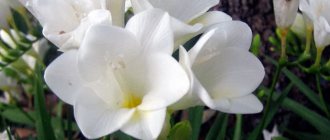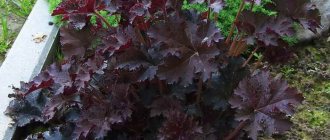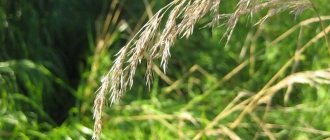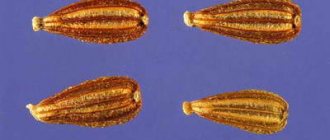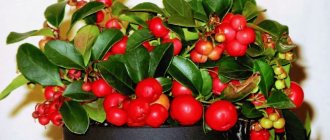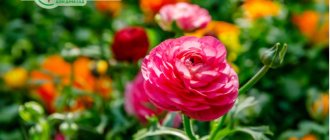Botanical description
The stems of the flower are varied: erect or recumbent, creeping, rising, always thickened, succulent, up to thirty centimeters long. The processes are pubescent with shiny “cilia”. The dense, fleshy leaves have reservoir papillae filled with juice that glistens in the sun like ice crystals.
How the crystal daisy blooms
Flowers with narrow petals, varied in color - white, pink, red, yellow, purple, lilac. A luxurious green carpet dotted with charming multi-colored flowers looks amazing. The inflorescences are quite large, up to seven centimeters. The bright “suns” appear only during the day, in clear weather. On cloudy days, only equally interesting leaves will decorate the garden. Flowers with positive energy lift your spirits, and the unusual Mesembryanthemum crystal amuses with its beauty, even when all the summer flowers have faded.
Next, a fruit resembling a box is formed. There are countless tiny seeds: one gram contains at least three thousand. Among the many species there are perennials and annuals.
Crystal grass application. Crystal grass - a refreshing vegetable
Crystal grass is a fast-growing creeping plant that in its natural habitat is usually found on the dry soil of South Africa and along the shores of much of the Canary Islands coastline. Crystal grass is pink or rose-red in color in hot, dry conditions, which in itself makes it a very attractive plant. Thickets of this plant often cover large areas of land with an amazing living red carpet.
Few people know that most of the most beautiful and famous landscape photographs and artistic paintings of the Canary Islands, and especially Tenerife, captured this amazing plant in conjunction with bizarre rocks, sands and the sea. Crystal grass is not native to these islands; it was introduced there and cultivated in the early 19th century for the production of soda and soap. And then I just stayed there to live.
The flowers of this plant are also very beautiful. They look a bit like large daisies and are usually creamy white in color. When their calyxes are fully open, they contrast beautifully with the reddish or green foliage around them, which also sparkles in the sun with tiny crystals.
After flowering, crystal grass produces multi-seeded fruits that are actually edible and were used as food in times of food shortage in earlier centuries, just like the leaves of this plant. Crystal grass turns brown after flowering and dries up, but the thousands of seeds in its fruit resurrect the plant again when the rains return to the earth.
Today, this plant also grows in wastelands and abandoned agricultural lands, but more often it can still be found along the sea coast and even right on the sandy tops of beaches.
Botanical portrait
Crystal grass, or more precisely crystal mesembryanthemum (Mesembryanthemum crystallinum) is a very decorative annual succulent belonging to the Aizoaceae family. The Latin name comes from the two mesembria + anthemon, meaning midday and flower. Most species of this plant open their inflorescences only during the day in sunny weather.
Many creeping recumbent stems about 10-15 cm high with fleshy leaves of pale green color, growing, form a continuous carpet, as if sparkling with small crystals of frost and woven for the palace of the Snow Queen. The leaves of this unusual plant are covered with shiny glandular hairs - papillae with transparent droplets of juice, which are designed to accumulate moisture and give it a unique charm. It is because of these transparent bubbles, very reminiscent of sparkling crystals of frost, that the plant got its name - crystal grass.
Crystal grass blooms with numerous chamomile-like flowers, consisting of a large number of very narrow petals, flowers with a diameter of 4-5 cm, collected in racemose inflorescences of 3-5. The flowers are white, pinkish or red.
The fruit is a five-leaf capsule. The seeds are very small.
Medicinal properties
In 1994, during scientific research in Lanzarote, the amazing healing properties of this plant were discovered.
Fresh crystal herb juice is an excellent remedy for the treatment of numerous skin diseases, including such severe ones as neurodermatitis and psoriasis, and is used as an ingredient for medicinal baths, and is also used in the manufacture of various medicinal ointments and cosmetic creams.
Based on this plant, various products are also produced to protect the skin from the harmful rays of the sun and treat sunburn.
Crystal grass can also be used for cosmetic purposes. Since its leaves contain 99% water, they can be used in the morning to wash your face instead of lotion. This natural wash does not dry out the skin and does not cause irritation. Additionally, crushed leaves can be used instead of soap.
Growing mesembryanthemum from seeds at home
Mesembryanthemum seeds photo
Growing Mesembryanthemum crystal with seeds is popular, since it can be impossible to buy seedlings, but getting seeds is much easier.
Light, loose soil is prepared from a mixture of earth and sand; more sand is taken and cassettes or seedling boxes are filled.
When to sow mesembryanthemum for seedlings
Sow mesembryanthemum in late March - early April. Earlier sowing will lead to stretching of seedlings (lack of light affects). Seedlings become brittle and develop poorly.
How to sow
- The seeds are scattered over the surface as little as possible; it is better to immediately use a toothpick and place them at a distance of 2-3 cm, so as not to break them later, damaging the roots.
- lightly sprinkle sand on top;
- the embedment depth does not exceed 2 - 3 mm;
- maintain temperature +12-15º C;
- crops are sprayed with a spray bottle and covered with film;
Mesembryanthemum growing from seeds photo shoots
- shoots emerge on the 7-8th day (the main ones - after 21-28 days), then the film is removed and transferred to a bright windowsill without drafts;
- seedlings that are too elongated are treated with retardants, which slows down excessive growth in length and increases the division of stem cells in width;
- water moderately, preventing the roots from rotting;
- the temperature is reduced to + 10º C;
Mesembryanthemum seedlings photo
- grown seedlings, at the stage of appearance of two to four true leaves, are planted in separate pots or cassette cells.
- Further care consists of maintaining moderate humidity of the substrate, providing bright diffused lighting and a cool temperature within 10-16 °C.
How to plant mesembryanthemum seedlings in the ground
- planted in open ground in the second decade of May or early June at a constant temperature of at least + 6º C, after the threat of frost has passed;
- planting pattern 10x15 cm. For varieties with long shoots - up to 30 cm;
- Landing location: sunny, southern slopes.
Mesembryanthemum crystal prefers exceptionally light soil with a weak fertile layer and excellent drainage. To protect the stems and leaves from rotting, small pebbles are placed near the bushes.
Ice grass flower. Description and types
In Russian translation you can find the names of this genus as sunflower, midday.
Mesembryanthemums are succulents with creeping creeping stems, 10-15 cm high. The leaves are fleshy, dense, designed to store moisture. After all, in their homeland, mesembryanthemums grow on sandy or rocky soils in arid regions.
Mesembryanthemum leaf under magnification
The leaves contain special surface cells, the so-called idioblasts, which give the entire plant a sparkling appearance in shiny drops. Hence another name for this plant - crystal, ice grass.
Mesembryanthemums are extremely thermophilic and cannot tolerate even a slight drop in temperature.
The genus, according to various sources, has 50-80 species. The most common:
- mesembryanthemum crystalline is the most common species;
- mesembryanthemum is grass-like with reddish stems and bright pink flowers with a dark center;
- mesembryanthemum is daisy-shaped, having flowers of a wide variety of colors;
- mesembryanthemum cloudy is a frost-resistant species, but with a short flowering period.
In our gardens, mesembryanthemum is not widespread. Perhaps gardeners are wary of some difficulty in growing this plant. Believe me, this is not true!
Mesembryanthemum is undeservedly underestimated. But it is so indispensable for an alpine hill, ridge, border, small clearing. Its bright pink, red, white, orange, and less often yellow flowers, similar to daisies, will decorate any flower garden.
When and how to sow crystal chamomile seeds in the ground
In the southern regions, seeds can be sown in open ground no earlier than May, but the midday flower will bloom much later. The emerging seedlings should be thinned out so that the strongest specimens remain. The distance between them is about 20 cm.
African chamomile is very thermophilic, the most it can tolerate is zero degrees for a short time. Fragile stems and the destructiveness of low temperatures are all the disadvantages of the plant. Otherwise, the Mesembryanthemum brings only joy. The flower garden containing the ice grass is literally transformed.
Decorate the garden with crystal grass. Content
The leaves of the mesembryantheum are succulent - fleshy, dense, thickened. As they grow, they branch heavily and spread along the ground, so the plant can be used as a ground cover. People call it glass (ice, crystal) grass - and not without reason. The dense leaves are covered with growths that look like drops of water, ice crystals or tiny pieces of glass. The complex name of the plant translated means midday flower - the beautiful bright inflorescences of many types of mesembryanthemum open only on a sunny day. On a gloomy day and in the evening the buds close.
Every owner wants his garden to be unusual in some way. This can be achieved using living decor. Agree that the unusual appearance and beauty of this flower allow you to create amazing compositions
Dorotheanthus is the name of one of the varieties of the flower, translated as “flower given by God.” It was probably named that way for its exceptional beauty and unusualness. It is dorotheanthus that is most often used in landscape design. Dorotheanthus bellidiformis daisy-shaped is universal - graceful, bright flowers will highlight the line of the garden path border, with the help of a monoplant you can create a beautiful flower bed, the colored spots of dorotheanthus on a carpet planting will delight you starting in July. Dorotheanthus is also good in combination with other, taller flowers, for example, bells and roses.
Propagation of mesembryanthemum by cuttings
Cuttings of mesembryanthemum photo
The fragility of the shoots is compensated by their ability to reproduce by cuttings. Roots at each lobe of the stem appear very quickly during cuttings.
- in the fall, select strong healthy bushes and dig them up;
- leave in a dark, cool place until spring;
- stored at a temperature of about +10ºC;
- divided into cuttings;
- placed for rooting in wet sand;
- The cuttings are not watered for three days, then carefully introduce bottom watering through the pan, avoiding waterlogging.
- after the appearance of young leaves, they are transferred to open ground (March-May, depending on the climatic zone);
- The soil for planting is preferably sandy, the place must be dry and bright.
Important: cuttings like to be capricious, you need to make sure that the water in the area does not stagnate, you need to water it moderately. Otherwise, rotting is possible. After a short interval of time, the root system is formed and the plant grows rapidly. There is no need to trim the crop.
Breeding and care
African chamomile is an amazing plant that produces a whole “carpet” of bright flowers. Some gardeners are afraid to breed it due to Mesembryanthemum’s strong love for the scorching rays of the sun. But there is no need to be afraid. The result will exceed all expectations.
When choosing land area for breeding Mesembryanthemum, the following aspects should be taken into account:
- Lighting is the most necessary condition when planting this type of plant. You need to choose that part of the site where the sun remains for the longest amount of time during the day.
- The plant does not like drafts. A well-ventilated place is required, but without drafts.
- Under no circumstances should mesembryanthemum be planted in the shade. If there is insufficient light, the plant will simply stop developing.
- The species of the Aizov family prefers light sandy or rocky soil that allows water to pass through.
- Mesembryanthemum needs fertilizing in the form of mineral fertilizers, which must be added during the development phase of the plant during the formation of buds.
- Like any other plant, Mesembryanthemum is not adapted to high moisture and dampness. Watering should be restrained. This procedure is only suitable for young and potted specimens. Excessive moisture causes rapid rotting of the roots.
Important! Mesembryanthemum should not be planted next to moisture-loving plants. Frequent watering can cause significant harm to it.
Winter storage
Before the first frost appears around mid-October, the plant is completely dug up along with the roots . Then the soil is removed from the roots, if necessary, dried. In winter, the plant in this form is stored in a dry place at a temperature of 9-11 degrees.
Diseases
The plant is invulnerable to various pests and diseases, therefore it qualifies as undemanding and easy to grow.
Mesembryanthemum at home
African chamomile can be grown as an indoor crop; the varieties Mesembryanthemum tiger and Mesembryanthemum white Echinatum are suitable for this. On the window it prefers only the sunny side.
The growing season requires moderate watering and bright, diffused lighting; during the dormant period, the plant does without watering, and the temperature is reduced to 10-16°C. Tolerates dry room air well. On hot days it requires spraying the area around it. To make the composition luxurious and lush, you need to plant several plants in one container.
How to care for crystal daisy
Mesembryanthemum is a relatively rare flower. Seeds are not sold everywhere; gardening guides rarely mention it. But those who chose this plant to decorate their garden will forever remain its admirers.
Mesembryanthemum crystalline does not require special care; you just need to follow some simple rules. The southern guest prefers slightly alkaline soil, will not suffer from temporary drought, and tolerates heat excellently.
Watering
Overmoistening during rainy summers and spring frosts can be disastrous - stagnation of water causes the roots to rot, and frost destroys the above-ground part. If the plantings are withering, you should stop watering until the plants recover. Lack of light will cause the shoots to stretch and flowering will weaken. Midday needs a sunny place. Does not bloom in the shade. When it gets cold, flowering bushes are wrapped in covering material; when warm weather returns, the covering is removed, then flowering will continue.
Feeding
Care involves fertilizing twice a month - from May to September. If you cut the stems of the plant before the cold weather and take it into the room, flowering will continue even without water, thanks to the beneficial substances and moisture accumulated inside the leaves.
Wintering
The African flower does not tolerate negative temperatures, so the plants are dug up for the winter, kept without watering in a bright room at a temperature of +10-12 °C until spring, or grown as an annual crop.
Features of plant care
Mesembryanthemum is an unpretentious ornamental plant, but despite this, it must be cared for correctly. In return, the flowers will delight you with their beauty.
There is no need to prune the ornamental plant. The stems spread along the ground, forming a bright and attractive flowering carpet.
Watering
The mesembryanthemum does not need much moisture. Only young animals require more water. But here you need to be extremely careful. With stagnation, there is a high risk of rotting of the root system. If the soil is excessively moist, watering should be interrupted for several days.
In the fall, the bushes of the ornamental plant should be transplanted into pots for further propagation at home. Mesembryanthemum tolerates heat well, but then there is a need for additional moisture.
You should spray water into the air using a spray bottle.
Feeding
Mesembryanthemum does not like a lot of nutrients. Therefore, we completely exclude bait. Fertilizers can be used only if there are signs of a lack of micro- or macroelements.
When planning a transplant for next year, you need to take care of feeding. The most favorable period for this will be May-August. Nutrients should be added no more than once every 15 days.
As fertilizers for mesembryanthemum, you should use special baits intended for succulents and cacti.
Wintering
Mesembryanthemum is a lover of African heat, and therefore reacts negatively to cold. At zero degrees, the ornamental plant dies. That is why it should be replanted before the onset of cold weather.
In winter, crystal grass should be kept in greenhouse conditions, where the temperature does not drop below +5 °C. Flower greenhouses or greenhouses are perfect for this.
You can take ornamental plants home to eliminate the possibility that they will die
Temperature
The African endemic is unpretentious. The plant is not demanding in summer and spring, feeling great at temperatures above +20 °C. But excessively high temperatures also have a negative effect on the mesembryanthemum. This is fraught with exposure of the bottoms of the shoots, which negatively affects the condition of the ornamental plant.
Lighting
The mesembryanthemum also experiences discomfort in insufficient lighting. In such conditions, the ornamental plant blooms and stretches poorly.
It is recommended to place the sunflower in a southerly direction in the brightest light possible. In such conditions, the flower requires minimal care
Types and varieties of Mesembryanthemum with photos and names
Among the fifty varieties and varieties, the most popular are:
- Mesembryanthemum hair-flowering;
- Mesembryanthemum ocelli;
- Mesembryanthemum crystalline.
Mesembryanthemum criniflorum or Dorotheanthus daisy
Mesembryanthemum criniflorum photo
Midday grows up to 10-15 cm, creeping shoots - up to 30 cm. It has flowers of various colors, up to 3.5 cm in diameter.
Mesembryanthemum occulatus
A yellow-flowered species with a delightful red center.
Mesembryanthemum crystallinum or Crystal grass
Mesembryanthemum crystallinum photo
The most famous perennial among gardeners. Strong shoots always sparkle with “droplets”, so both shoots and leaves are very decorative. The colors of the flowers are the most varied.
Famous varieties:
- Mesembryanthemum Limpopo, blooming June - October;
- the Frost variety is one of the rare ones, bred by breeders;
- Mesembryanthemum Sparkles with large, up to 4.5 cm, yellow-white leaves and large shoots.
Popular varieties: Lunet, Northern Lights, Apricot pointe shoes that do not close in cloudy weather.
Crystal grass benefits. Crystal grass "Rime"
I had a picture in one of my posts before the New Year. A packet of crystal herb seeds “Rime”.
Many people liked the name. Good. And the plant itself is amazing and wonderful.
Crystal grass, also known as ice plant, or crystalline iceplant, is a crystal mesembryanthemum, Mesembryanthemum crystallinum, a plant from the aizoaceae family, Aizoaceae. This family is familiar to many thanks to its unusual terminal plants - lithops, fucaria, conophytums. They are also called living stones. But about them another time. Now - about crystal grass - mesembryanthemum.
I first met her many years ago. At an impromptu market near the station, I bought seedlings of an unusual plant from my grandmother. It gave the impression of extraordinary fragility, and the sun's rays glittered on its leaves, like on shards of glass. I planted a plant at the dacha. The year was dry, and many flowers were sad without regular watering. Not my crystal grass. It grew in breadth and became covered with amazing star flowers.
Another time I planted crystal grass in a pot on the balcony. But the summer was rainy and cloudy, my crystal grass grew like a carpet, but there were few flowers on it.
Mesembryanthemum crystallinum, Flora Graeca, vol. 5:t. 81 (1825)
First, about the leaves. Their surface looks strange. All pimply. Indeed, it’s like glass. Here's what it looks like at relatively high magnification.
Photo from here.
Each such bubble is one cell. They are here for a reason. Crystal grass happens to live not only on salt marshes, but on brackish soils. The trouble with salinity is that the cells become dehydrated. Everyone can feel this for themselves. All you have to do is eat your fill of herring and you will immediately want to drink. Plants that can live on saline soils have osmoprotectors in their vacuoles - low molecular weight compounds that prevent the outflow of water. In addition to resistance to salinity, osmoprotectors increase resistance to drought and cold. Hence the endurance of crystal grass despite its apparent tenderness.
A substance called pinitol acts as an osmoprotector in the vesicular cells of the mesembryanthemum. Interesting stuff. Relevant to the treatment of diabetes. It is obtained not from mesembryanthemum, but from soybeans. But the gene encoding myo-inositol methyl transferase, a key enzyme in the production of pinitol, was isolated from Mesembryanthemum crystallinum, and now this gene is introduced into soybean cells and pinitol is obtained using these transgenic plants.
In the photo on the right, the cells have a purple tint. Indeed, the leaves of the mesembryanthemum are reddish. They are colored by a substance called betalain. It also gives red color to beets (the Latin name for beets is Beta), bougainvillea and amaranth flowers. Very good permanent food coloring. But there is still more of it in beets than in crystal grass.
The miracles don't end there. I planned to write about mesembryanthemum back in mid-January. And in this very place I got stuck. Instead of an article about crystal grass, the result was an article about photosynthesis. Anyone who is not too lazy is invited to look into it. For those who are too lazy - a summary.
In order to obtain from simple inorganic substances, from which everything that we call “non-living” is composed, all the variety of organic substances from which all living things are composed, there is a thing on our planet called photosynthesis. To carry it out, the energy necessary for the process is first stored in the chloroplasts, and then a carbon dioxide molecule joins the five-carbon chain of ribulose biphosphate and forms a six-carbon compound (C 6 ), which is so unstable that it immediately falls apart in half, forming two three-carbon chains (C 3 ). And this whole story is called C 3 photosynthesis. For more details, follow the link above.
Everything would work out very well, but not everywhere on our planet is it warm and humid enough for any plant to indulge in C3 photosynthesis without restrictions. And not only the lack of water and light is the reason for this, but primarily the lack, oddly enough, of carbon dioxide. In dry, hot places, the plant has to keep its stomata closed during the day so as not to lose water. Carbon dioxide enters the plant through the stomata. The stomata are closed - the import of carbon dioxide is blocked. What to do?
For this case, there is a clever thing called C 4 photosynthesis. Its essence is that in the first stages, not a three-carbon compound - 3-phosphoglycerate, but a four-carbon oxalacetate is formed in the cells of the leaf.
Then miracles begin. With 4 plants have a cunning leaf arrangement. Their conducting bundles are surrounded by cells, which in Russian are usually called the word “lining”. Other languages use the German term, Kranz - crown, and there is even the term Kranz-anatomy.
Look how beautiful it is.
Amazing photo from here.
Mesembryanthemum in landscape design
Mesembryanthemum in landscape design photo
Mesembryanthemum is a real find for landscaping. Both leaves and flowers have stunning decorative properties. In the shade, the plant can be grown as a ground cover - there will be no luxurious flowering, but the ground will be covered with a carpet of amazing dense leaves with growths in the form of dew drops.
Midday flowers look interesting, so they are often planted in the foreground of compositions. Used to decorate alpine slides, fences, slopes, artificial reservoirs. Crystal grass is combined with bulbous, corm, tall roses, bells, or used to create monoflower beds. The main thing is not to go too far with the number of colors, they are very bright, “they take the whole view on themselves.” African chamomile is cultivated as a container plant to be placed on balconies and terraces.
Important: when forming a flower garden from Mesembryanthemum, you should pay attention that among the whole variety of crystal chamomile there are no blue shades. The emptiness will have to be replaced with any other colors with this shade.
Diseases and pests
Mesembryanthemum has high resistance to harmful insects and diseases. The most serious problem is unfavorable weather conditions, namely high humidity and lack of sunlight.
Diseases
The most common mesembryanthemum disease is root rot. You can trim off the damaged areas and try spraying with a fungicide. But in most cases this does not give any result.
Root rot
Harmful insects
The only problem is spider mites. This pest prefers the same conditions as the glass daisy. At high humidity, the pest dies, but such conditions are also unacceptable for an ornamental plant.
To kill spider mites, it is recommended to use acaricides. The most effective are “Akarin”, “Aktellik”, “Fitoverm”, “Aktara”. You can wash the leaves with laundry soap or garlic water. It is recommended to repeat this procedure 2-3 times.
Spider mites
Useful properties of mesembryanthemum
Reviews about the properties of Mesembryanthemum crystalline vary. On the one hand, there is information about its use in cosmetology and cooking. African tribes grow midday as a vegetable crop. The leaves stewed with butter are similar to spinach.
Experts have isolated an anti-wrinkle extract from crystal chamomile. It is impossible to prepare a miraculous extract at home by boiling or infusing flower leaves.
From other sources, Mesembryanthemum is not a pharmacopoeial plant. Due to the content of psychotropic substances, official medicine does not use this plant as a medicinal plant. Light doses of aqueous extracts from the stems relax muscles and promote a feeling of mild euphoria. Significant dosages can provoke the appearance of visions and hallucinations, which is why midday is used by the indigenous peoples of Africa for ritual purposes. For this reason, several American states have legally prohibited its cultivation.

